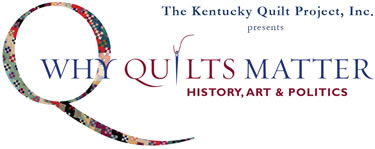Purely American – by Bill Volckening
Piecework, appliqué and quilting together layers of fabric all have roots in ancient cultures, from Asia to the Middle East. The tradition of quilts as bed covers grew in Western Europe. So, where does America come in?
None of the basic techniques were developed here. We adopted Western European traditions and whole cloth quilts, simple geometric piecework and other decorative methods. Once more domestically produced fabric became available, Americans started to elevate quiltmaking into a high art form using creativity and original design. We invented new block patterns, and many were bold, eye-catching, and full of meaning.
 “New York Beauty” is one such striking quilt pattern, born in the middle 19th century in the Southeastern United States. The pattern includes curved seams and sharp points, and the block design consists of four quarter circles wedged in the inside corners of a parallelogram, with points or spikes on the outer curve of each wedge. It is a very challenging test of sewing skill, not for beginners, intimidating to even the most experienced quiltmakers. It is also among the earliest quilt designs we can call purely American.
“New York Beauty” is one such striking quilt pattern, born in the middle 19th century in the Southeastern United States. The pattern includes curved seams and sharp points, and the block design consists of four quarter circles wedged in the inside corners of a parallelogram, with points or spikes on the outer curve of each wedge. It is a very challenging test of sewing skill, not for beginners, intimidating to even the most experienced quiltmakers. It is also among the earliest quilt designs we can call purely American.
The oldest examples of the “New York Beauty” were found in Kentucky, Tennessee, and other Southeastern states. These quilts werenít known by the name New York Beauty at that time. A search of The Quilt Index produced at least 18 names, and the most common names were Rocky Mountain Road and Crown of Thorns.
These names referred to religion and westward migration, and the sun is an important icon throughout. From the very beginning, these quilts were granted great importance and stature. They were “best” quilts, dowry or wedding quilts, and typically included fine piecework, dense quilting, and elaborately pieced sashing and cornerstones.
The name “New York Beauty” was first associated with the pattern in 1930, when Stearns and Fosterís Mountain Mist division published a pattern based on an old design, and coined the name. Since then, the name just stuck. Quilts made before 1930 were retroactively called “New York Beauty” and there were two main reasons.
Mountain Mist’s account of the pattern’s history was highly romanticized. This description said the quilt pattern was from 1776, but historical research doesnít support that claim. This type of romantic notion about quilting in during the Revolutionary War was filled with conjecture and myth.
More recently, the quilt pattern experienced its own revolution, with artists introducing foundation piecing and innovative designs. In the last 15 years, influential books written by artists such as Karen Stone and Valori Wells ushered in a new wave of quilts. Kaleidoscopic, boldly colored, and playfully pieced, the newer quilts were infused with whimsy. Yet todayís quilters still regard the New York Beauty as a quilt of great importance and stature.
From the moment I saw my first New York Beauty, the design, with all its sharp points and difficulty, really got my attention. And it held my attention! That was in 1989, and I’ve collected them ever since. Some of them were in the August/September, 2012, issue of Quilters Newsletter Magazine, and I was just delighted to share them.
Next month, one of the quilts is headed to Bellingham, Washington, for the “American Quilts, The Democratic Art, 1780-2007” exhibit, curated by Bob Shaw and Julie Silber, at the Whatcom Museum. I will bring a group of the quilts to Lincoln, Nebraska, for the American Quilt Study Group Seminar in October. And next year, they will be on display at the San Jose Museum of Quilts and Textiles. It will be an oasis of beauty, the life story of a purely American quilt.
Bill Volckening
Portland, Oregon
http://www.billvolckening.com
Image Credits:
Photos courtesy of Bill Volckening.
Top: This pieced quilt was made in the 1860s in Kentucky, and appears in “Why Quilts Matter” documentary. It was once part of Susie Tompkins’ Esprit Collection.
Left: Detail of the MacMillan Family Quilt, 1868, from Monroe County, Kentucky. This quilt was included in Kentucky Quilts.


